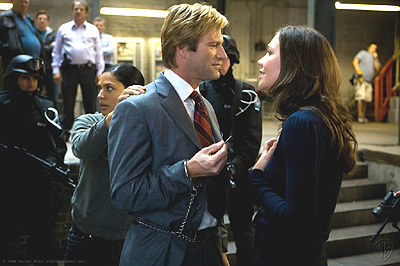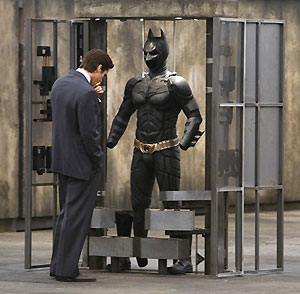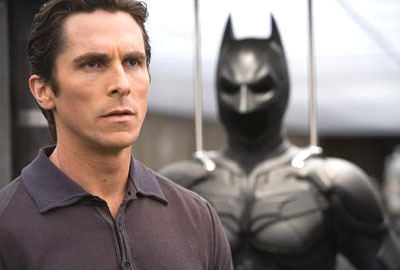The Abyss Gazes Into Thee: Batman, The Dark Knight, and Modern Gothic
Published on September 29th, 2008 in: Books, Comics, Halloween, Horror, Issues, Movies |Throughout The Dark Knight, we witness Harvey make decisions by flipping his “lucky coin,” much to the dismay of Rachel and Batman who tell him that he can’t leave such things to chance. However, it’s a rigged game; Harvey’s coin bears the same image on both sides. This seems to be a metaphor for the good guys being as corrupt as the criminals; they don’t play fair. This metaphor is pushed to the limit when we discover that the very cops Harvey pursued in IAB—the ones Gordon trusts—are responsible for Rachel’s death and his own disfigurement.

By relying on chance, Two-Face removes the opportunity for individuals to make choices, something that speaks directly to the philosophy of Batman and reveals the method behind The Joker’s madness. Alfred warns Bruce against hanging up his Batman cowl by reminding him that as Batman, “he can be the outcast. He can make the choice that no one else can make—the right choice.”
Yet, The Joker twists this logic to mock Batman about his rule against killing. He tells him “killing is making a choice” but turns the phrase on its head by forcing Batman to make a choice as to who will die: Rachel or Harvey. Thus “making a choice is killing.”
The Joker insists to Batman “the only sensible way to live in this world is without rules,” referring to himself as an “agent of chaos,” and telling Harvey, “You know the thing about chaos? It’s fair.” Two-Face follows this example, using his coin as the “agent of chaos” as he taunts Gordon by holding his son at gunpoint, shouting, “It’s not about what I want! It’s about what’s fair! You thought we could be decent men in an indecent time! But you were wrong. The world is cruel.”
The moral quandaries of a cruel world are an integral part of Gotham City as well as Batman himself. Punter raises the question of morality in Gothic: “If an empire based on morality declines, what are the implications for the particular morality concerned?” (21) This speaks directly to the genesis of Batman.
In Batman Begins, Bruce Wayne splits from the League of Shadows because his moral code will not allow him to become an executioner. He creates Batman to restore the declining morality in Gotham. Yet in The Dark Knight, The Joker tries to expose the hypocrisy of the Gotham police force by mocking such moral codes, calling them a “bad joke,” and predicting that they’ll be “dropped at the first sign of trouble. They’re only as good as the world allows them to be.” In a cruel world choice becomes meaningless.
The world of Gotham City—one which restricts human action and corrupts the good—is not as fictional than it may seem. In exploring the concept of abjection (degradation) in Gothic, Punter relates it to the restricting, corrupting influence of capitalism, saying:
“. . . abjection arises from the sense of the gap, the abyss, between power and powerlessness, and will. . . be necessarily intensified as the difference between the apparent power of individuals to influence their own lives and the actual perpetuation of systems of power, which render this potential impotent continues. . . to crystallize.” (22)
It is rejection of such a capitalist system that brings Bruce Wayne to his lowest point in Batman Begins: running away from his privileged life and becoming part of the criminal world. Yet he insists he was only a spectator: “The first time I stole so that I wouldn’t starve. I lost many assumptions about the simple nature of right and wrong. And when I traveled, I learned the fear before a crime. And the thrill of success. But I never became one of them.”

Although it is Bruce’s embracing of the capitalist system that allows Batman to flourish—he uses his company’s vast resources to develop his armory, weapons, and research—it also allows him to conceal Batman’s true identity. One can’t help but observe that such dishonesty is criminal, particularly in The Dark Knight when by not speaking up, Bruce “saves” Batman but allows Harvey to take the fall.
This tension between good and evil, between power and powerlessness, degrades Bruce both socially (he can’t reveal his true self; he has no close friends or lovers) as well as psychologically (his two selves are at odds and cannot be resolved into a cohesive whole) the longer that Batman continues to exist; he is beholden to the very system of power which prevents others from fulfilling their own personal potential and thus, leading them become criminals. This vicious cycle is the most obvious and nihilistic manifestation of the villain-hero: a hero who by his very existence creates the villains he fights against.
Such nihilism in Gothic is described by Punter as a “bitter and exhilarating confirmation that the worst we have always suspected is right around us, and that the only ‘choice’ we have is whether to play our part in a gallery of psychopaths which is, nonetheless not very far from our experience of the institutions of power.” (23)
In this way, Bruce Wayne/Batman, Harvey/Two-Face, and The Joker are all manifestations of the same black-hearted creature: psychopaths who perpetuate the system they profess to loathe. At the end of The Dark Knight, Batman tells Gordon what Harvey told him earlier: “You either die a hero, or you live long enough to see yourself become the villain.” Then he makes perhaps his most important choice: he decides to become the villain so that Harvey can remain a hero. By doing this, Batman attempts to create a legacy of good in Gotham, to preserve what little hope the city has left. Only in the modern Gothic world of Batman could becoming a villain save humanity.

Sources:
1. A Glossary of Literary Gothic Terms, student contributions to the Spring 2001 edition of the class “Introduction to Literary Studies” at Georgia Southern University
2. David Punter, The Literature of Terror: A History of Gothic Fictions From 1765 To The Present Day, Volume 1: The Gothic Tradition, Second Edition (Longman Group Limited, 1996), 4
3. Ibid., 5
4. Ibid., 112
5. Ibid.
6. David Punter, The Literature of Terror: A History of Gothic Fictions From 1765 To The Present Day, Volume 2: The Modern Gothic, Second Edition (Longman Group Limited, 1996), 206
7. Ibid., 189
8. Sigmund Freud, “The Uncanny,” 1919
9. Ibid.
10. David Punter, The Literature of Terror: A History of Gothic Fictions From 1765 To The Present Day, Volume 2: The Modern Gothic, Second Edition (Longman Group Limited, 1996), 4
11. Sigmund Freud, “The Uncanny,” 1919
12. Ibid.
13. Mary Wollstonecraft Shelley, Frankenstein (Scholastic, Inc.), p. 44
14. David Punter, The Literature of Terror: A History of Gothic Fictions From 1765 To The Present Day, Volume 2: The Modern Gothic, Second Edition (Longman Group Limited, 1996), p. 111
15. Ibid., 107
16. Ibid., 4
17. Ibid., 2
18. Wikipedia, “Janus”
19. Ibid.
20. Aldous Huxley also used the term as the title of his book about his experiences with hallucinogens, reminiscent perhaps, of the ones Ra’s Al-Ghul utilizes to help Bruce Wayne “conquer his fear.”
21. David Punter, The Literature of Terror: A History of Gothic Fictions From 1765 To The Present Day, Volume 2: The Modern Gothic, Second Edition (Longman Group Limited, 1996), 3
22. Ibid., 211
23. Ibid., 212
Time limit is exhausted. Please reload the CAPTCHA.